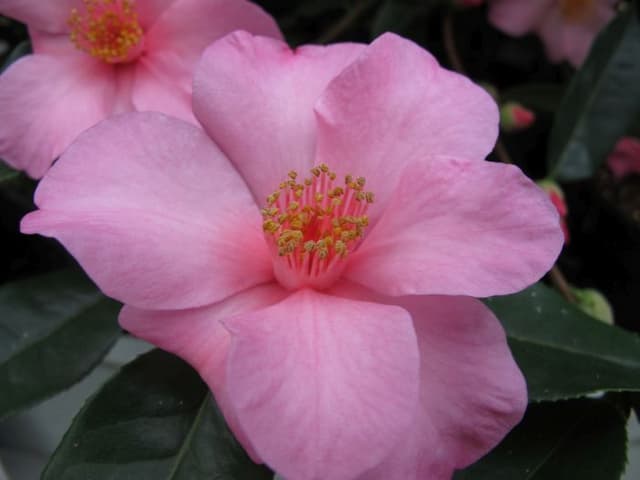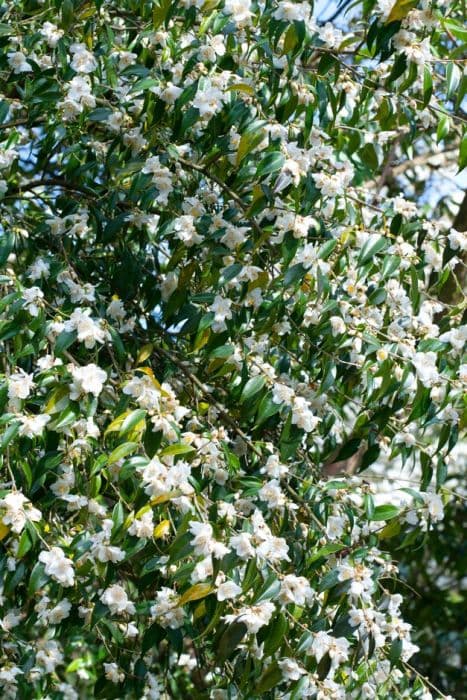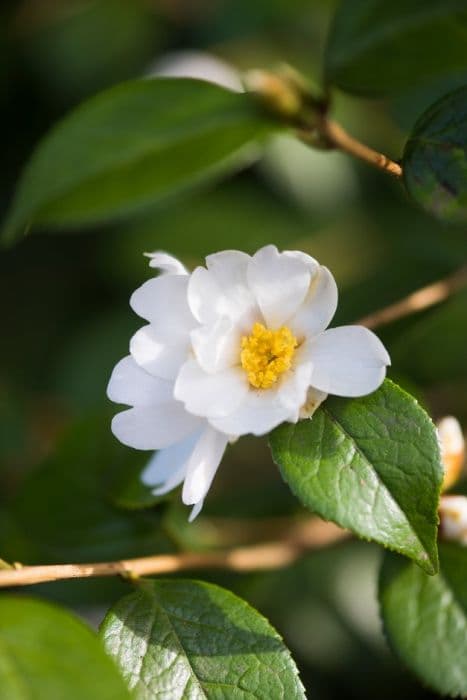Williamsii Camellia Camellia × williamsii 'E.g. Waterhouse'

ABOUT
The Camellia 'E.G. Waterhouse' is an evergreen shrub that is cherished for its beautiful flowers and glossy, deep green leaves. The leaves maintain their lustrous appearance throughout the year and provide a perfect backdrop for the stunning blooms. The flowers stand out with their formal double form, which means that they have several layers of petals gracefully arranged in a symmetrical pattern. The petals themselves exhibit a soft, pale pink hue that can range from almost white to a more pronounced pink, depending on light exposure and other growing conditions. These blooms are considered quite large and exude an exquisite, delicate beauty that can liven up any garden space. The flower buds reveal themselves as tight, plump spheres before unfurling their petals. When in full bloom, the Camellia 'E.G. Waterhouse' becomes a focal point of the garden because of the contrast between the vibrant flowers and the dark foliage. The overall growth habit of the Camellia 'E.G. Waterhouse' is upright with a tendency to form a rounded shape, giving it a bushy and substantial presence in the landscape. Its evergreen nature ensures that it provides year-round interest, even when not in bloom, thanks to its attractive, dense foliage. It is suitable for a variety of garden styles and makes an elegant addition to any plant collection. Owing to this plant's ornamental qualities, it is often planted as a specimen or used in groupings for greater visual impact.
About this plant
 Names
NamesFamily
Theaceae
Synonyms
Williamsii Camellia, Hybrid Camellia, Waterhouse Camellia
Common names
Camellia × williamsii 'E.g. Waterhouse'.
 Toxicity
ToxicityTo humans
Camellia hybrids, which include the Camellia × williamsii 'E.g. Waterhouse', also commonly known as Williamsii Camellias, are not considered toxic to humans. Therefore, there are usually no symptoms of poisoning associated with ingesting parts of this plant. However, it's always prudent to avoid eating ornamental plants due to potential pesticide use and the possibility of individual allergies or unexpected reactions.
To pets
Williamsii Camellias are generally regarded as non-toxic to pets such as dogs and cats. If a pet ingests parts of the plant, they are not likely to experience symptoms of poisoning. Nonetheless, caution is advised as overconsumption of non-food plants can potentially cause gastrointestinal upset in some pets, leading to symptoms like vomiting or diarrhea. It is always best to closely monitor your pets and prevent them from eating significant amounts of garden plants.
 Characteristics
CharacteristicsLife cycle
Perennials
Foliage type
Evergreen
Color of leaves
Green
Flower color
Pink
Height
6-10 feet (1.8-3 meters)
Spread
5-8 feet (1.5-2.4 meters)
Plant type
Shrub
Hardiness zones
7
Native area
East Asia
Benefits
 General Benefits
General Benefits- Aesthetic Appeal: Adds visual interest to gardens with its glossy evergreen foliage and ornamental flowers.
- Variety in Landscaping: Suitable for mixed borders, foundation plantings, and as a specimen plant.
- Wildlife Attraction: Flowers provide nectar and pollen for bees and other pollinating insects.
- Seasonal Interest: Offers a splash of color when it blooms, typically in winter to spring, brightening up the garden during dull months.
- Low Maintenance: Once established, it requires minimal care beyond occasional pruning and watering during dry spells.
 Medical Properties
Medical PropertiesThis plant is not used for medical purposes.
 Air-purifying Qualities
Air-purifying QualitiesThis plant is not specifically known for air purifying qualities.
 Other Uses
Other Uses- **Artistic Inspiration**: The Camellia 'E.g. Waterhouse' with its vibrant flowers has often been used as a subject in paintings and floral photography due to its aesthetic appeal.
- **Cultural Symbolism**: In some cultures, the Camellia is a symbol of love and devotion, making the 'E.g. Waterhouse' variety a significant gift plant for special occasions.
- **Clothing Dye**: Historically, Camellia flowers have been used to produce natural dyes for fabrics, and 'E.g. Waterhouse' can be utilized in the same way, adding a delicate color.
- **Floral Arrangements**: The cut flowers of 'E.g. Waterhouse' are long-lasting and ideal for use in sophisticated floral arrangements and bouquets.
- **Culinary Decoration**: Though not all Camellias are edible, the petals of some varieties can be used to decorate salads and desserts for an elegant touch.
- **Tea Ceremony Accent**: The aesthetic of Camellia 'E.g. Waterhouse' may be incorporated into traditional tea ceremonies as a symbol of grace and purity.
- **Educational Resource**: Botanic gardens and educational programs use Camellia 'E.g. Waterhouse' to teach about plant hybridization and horticulture practices.
- **Garden Design**: The plant is popular for use in creating Japanese and Chinese garden designs, where Camellias hold significant cultural importance.
- **Specialized Compost**: Fallen leaves and flowers of Camellia 'E.g. Waterhouse' can be added to compost heaps, where they decompose and enrich the soil with organic matter.
- **Ceremonial Uses**: Camellia 'E.g. Waterhouse' can be used in certain ceremonial practices, especially in East Asian cultures, where it may adorn temples or be part of traditional weddings.
Interesting Facts
 Feng Shui
Feng ShuiThe Camellia is not used in Feng Shui practice.
 Zodiac Sign Compitability
Zodiac Sign CompitabilityThe Camellia is not used in astrology practice.
 Plant Symbolism
Plant Symbolism- Admiration: Camellias often symbolize deep respect and admiration, making them a popular choice to express feelings of esteem.
- Perfection: The beauty and perfection of the camellia's blooms are associated with the ideal or perfect beauty.
- Longevity: Camellia plants are known for their longevity, both in terms of life span and the length of time their flowers stay fresh.
- Affection: Gifting camellias can suggest genuine, heartfelt affection towards someone.
- Devotion: The robust nature of the plant along with its lush flowers are often seen as a representation of deep dedication and loyalty.
 Water
WaterWilliamsii camellias prefer consistently moist soil but not waterlogged conditions. During the growing season, water using approximately 1 gallon per plant once a week. However, during periods of drought or extreme heat, increase watering frequency to twice a week. In the winter, cut back watering to every other week, paying attention to rainfall and adjusting as necessary. A deep watering is preferable to shallow sprinklings, as it encourages deeper root growth and increases the plant's drought tolerance.
 Light
LightWilliamsii camellias thrive best in partial shade with filtered sunlight. They should be planted in a location that receives morning light but is protected from the intense afternoon sun. Dappled shade under a canopy of tall trees is ideal, as it mimics their natural habitat.
 Temperature
TemperatureWilliamsii camellias are hardy and can withstand temperatures as low as 5°F, but they prefer a range between 60°F and 75°F. To ensure optimal growth and bloom, they should be protected from sudden drops in temperature and frosts, especially in spring when new growth is emerging. The ideal range is comfortable for most temperate climates.
 Pruning
PruningWilliamsii camellias should be pruned to maintain shape, remove dead or weak growth, and encourage air circulation. The best time for pruning is immediately after blooming has finished, typically in late winter or early spring. Prune lightly each year rather than severely cutting back the plant infrequently.
 Cleaning
CleaningAs needed
 Soil
SoilWilliamsii camellias thrive in acidic soil with a pH of 5.5 to 6.5. A mix consisting of two parts peat moss or leaf mold, one part loamy soil, and one part sharp sand or perlite provides the ideal structure and drainage they require for healthy root growth.
 Repotting
RepottingWilliamsii camellias should be repotted every two to three years. They prefer to be somewhat root-bound, so frequent repotting is not necessary.
 Humidity & Misting
Humidity & MistingWilliamsii camellias flourish in moderate to high humidity levels ranging from 40% to 60%. They perform well in the misty conditions of their natural understory habitat.
 Suitable locations
Suitable locationsIndoor
Position in filtered light, away from direct heat; mist foliage.
Outdoor
Plant in dappled shade, sheltered from intense sun and winds.
Hardiness zone
7-9 USDA
 Life cycle
Life cycleCamellia × williamsii 'E.g. Waterhouse', commonly known as Williamsii camellia, begins its life as a seed germinating in moist, well-drained soil in partial shade. The seedling stage follows, characterized by initial leaf growth as it establishes a root system. As it enters the vegetative stage, the plant develops more leaves and stems, gradually maturing over several years. The mature plant reaches the flowering stage, producing large, showy flowers typically from winter to spring. After pollination, the plant forms seed pods, and once mature, the seeds are dispersed to begin a new generation. Throughout its life, Williamsii camellia undergoes annual cycles of growth and dormancy, adjusted to seasonal changes.
 Propogation
PropogationPropogation time
Spring-Early Summer
The most popular method of propagating Camellia × williamsii 'E.G. Waterhouse', commonly known as the Camellia, is through semi-hardwood cuttings. This is often done in late summer, when the current year's growth has started to mature and harden slightly. Cuttings should be about 4 to 6 inches long and taken with a clean, sharp instrument. Leaves on the lower half of the cutting should be removed, and the cut end can be dipped into a rooting hormone powder to encourage root development. The prepared cutting is then inserted into a potting mix of peat and perlite or sand, maintaining high humidity and consistent moisture without waterlogging. To provide a humid microclimate, a plastic bag or cover can be placed over the pot. Roots typically develop within 6 to 10 weeks, after which the young Camellias can be gradually acclimated to less humid conditions before being transplanted.









